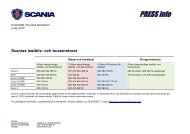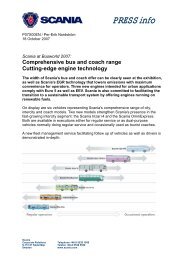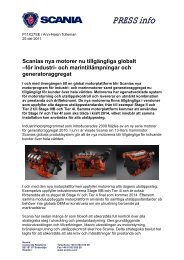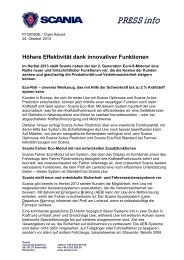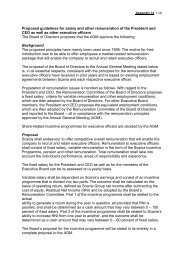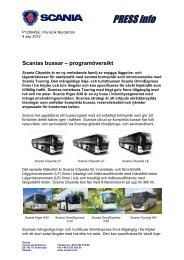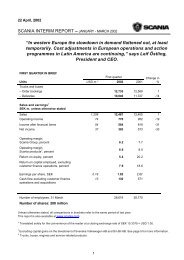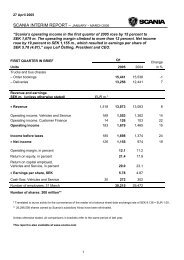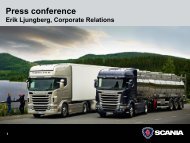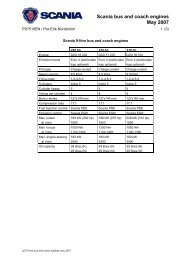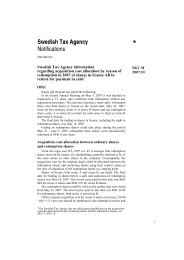Scania annual report 2004
Scania annual report 2004
Scania annual report 2004
You also want an ePaper? Increase the reach of your titles
YUMPU automatically turns print PDFs into web optimized ePapers that Google loves.
Closer to customers<br />
and their demands<br />
Today major transport companies compete by means of advanced logistics systems. Their customers<br />
demand that goods be delivered quickly and punctually – just-in-time, every time. That is why transport<br />
companies are investing in vehicles and in service that provide high quality and maximum uptime.<br />
Internationalisation, structural changes<br />
and increasingly active customers and<br />
consumers have transformed the transport<br />
industry. Demands for faster, more reliable<br />
and cheaper deliveries are forcing transport<br />
companies to improve the efficiency<br />
of the flow of goods, services and information.<br />
More and more hauliers are evolving<br />
into logistics companies with total responsibility<br />
for their customers’ transport<br />
needs. Meanwhile many smaller haulage<br />
firms are specialising or becoming subcontractors<br />
to large logistics companies.<br />
Such services as financing, insurance,<br />
short-term rentals and maintenance are<br />
in ever greater demand.<br />
New legislation<br />
The operations of transport and logistics<br />
companies are also affected by political<br />
decisions and new legislation. The European<br />
Commission recently adopted a<br />
proposal for changes in the Working Time<br />
Directive for commercial vehicle drivers.<br />
For the transport industry, one effect of<br />
this will be shorter working hours. The purpose<br />
is to reduce the number of accidents<br />
caused by exhausted drivers. Another EU<br />
directive will increase the requirements for<br />
in-service training of professional drivers.<br />
The aim is to improve road safety and reduce<br />
fuel efficiency.<br />
In order to satisfy new customer demands,<br />
in recent years <strong>Scania</strong> has made<br />
major investments, not least in its sales<br />
and service network. Today most of this<br />
network is owned by <strong>Scania</strong>. The integration<br />
process has created greater proximity<br />
to customers, who can choose the<br />
best combination of transport solutions<br />
from a large array of vehicles, services<br />
and financing.<br />
Truck customers<br />
A customer’s decision to choose a <strong>Scania</strong><br />
truck is rarely just about the price of the<br />
vehicle itself. More important are the total<br />
costs and revenues that the vehicle generates<br />
during its entire service life. Large<br />
transport and logistics companies prioritise<br />
vehicles with high operating reliability and<br />
good fuel economy. A well-developed service<br />
and road assistance network is<br />
important when every delivery must arrive<br />
on time. For small hauliers, a vehicle’s<br />
dependability and reliability are often vital.<br />
It is not unusual for the driver himself to<br />
own the truck. A cab with a good driver<br />
environment both for work and rest is<br />
often a weighty purchasing argument for<br />
an owner-operator haulier. Image means a<br />
lot too, since the truck becomes a small<br />
company’s most important calling card.<br />
In many European countries today,<br />
there is a shortage of well-trained professional<br />
drivers. Having the best truck makes<br />
it easier for a haulage company to recruit<br />
good drivers. And good drivers who drive<br />
good vehicles mean higher profitability.<br />
In South American markets, especially<br />
Brazil, there is a continued trend towards<br />
larger and larger combinations for heavy<br />
haulage in the agricultural sector, but also for<br />
tanker haulage. So-called “BiTrem” – tractors<br />
with two semitrailers – are increasingly being<br />
used to improve total transport economy.<br />
The gross weight of the rig can be increased<br />
to a maximum of 57 tonnes, compared to<br />
45 tonnes previously. The trend has favoured<br />
<strong>Scania</strong>, which dominates this segment.<br />
The use of such rigs reinforces the need<br />
for high engine power, which coincides<br />
with <strong>Scania</strong>’s strategy and its famously<br />
robust, powerful engines.<br />
Bus and coach customers<br />
<strong>Scania</strong>’s customers in city bus services<br />
are often private operators, in many cases<br />
active in more than one country. To a<br />
growing extent, they are demanding total<br />
transport solutions. Service and repair<br />
contracts, financing and traffic planning<br />
are examples of the elements that may<br />
be included in <strong>Scania</strong>’s bus business.<br />
Customers in the tourist coach segment<br />
previously composed their own coach by<br />
ordering the chassis from one manufacturer<br />
and the body from another. Today more<br />
and more customers, especially in Europe,<br />
want to buy complete buses from one<br />
supplier. <strong>Scania</strong> solves this with the help of<br />
partnerships with a number of selected<br />
bodybuilding companies.<br />
In South American markets, a number<br />
CUSTOMERS • SCANIA ANNUAL REPORT <strong>2004</strong> 20



